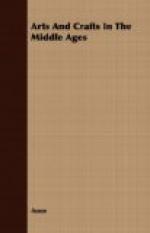[Illustration: MEDIAEVAL ILLUMINATION]
The divergences of style in the work of various countries are well indicated by Walter de Gray Birch, who says: “The English are famous for clearness and breadth; the French for delicate fineness and harmoniously assorted colours, the Flemish for minutely stippled details, and the Italian for the gorgeous yet calm dignity apparent in their best manuscripts.” Individuality of facial expression, although these faces are generally ugly, is a characteristic of Flemish work, while the faces in French miniatures are uniform and pretty.
One marked feature in the English thirteenth and fourteenth century books, is the introduction of many small grotesques in the borders, and these little creatures, partly animal and partly human, show a keen sense of humour, which had to display itself, even though inappropriately, but always with a true spirit of wit. One might suppose on first looking at these grotesques, that the droll expression is unintentional: that the monks could draw no better, and that their sketches are funny only because of their inability to portray more exactly the thing represented. But a closer examination will convince one that the wit was deliberate, and that the very subtlety and reserve of their expression of humour is an indication of its depth. To-day an artist with the sense of caricature expresses himself in the illustrated papers and other public channels provided for the overflow of high spirits; but the cloistered author of the Middle Ages had only the sculptured details and the books belonging to the church as vehicles for his satire. The carvings on the miserere seats in choirs of many cathedrals were executed by the monks, and abound in witty representations of such subjects as Reynard the Fox, cats catching rats, etc.; inspired generally by the knowledge of some of the inconsistencies in the lives of ecclesiastical personages. The quiet monks often became cynical.
The spirit of the times determines the standard of wit. At various periods in the world’s history, men have been amused by strange and differing forms of drollery; what seemed excruciatingly funny to our grandparents does not strike us as being at all entertaining. Each generation has its own idea of humour, and its own fun-makers, varying as much as fashion in dress.
In mediaeval times, the sense of humour in art was more developed than at any period except our own day. Even-while the monk was consecrating his time to the work of beautifying the sanctuary, his sense of humour was with him, and must crop out. The grotesque has always played an important part in art; in the subterranean Roman vaults of the early centuries, one form of this spirit is exhibited. But the element of wit is almost absent; it is displayed in oppressively obvious forms, so that it loses its subtlety: it represents women terminating in floral scrolls, or sea-horses with leaves growing instead of fins. The same spirit is seen in the grotesques of the Renaissance, where the sense of humour is not emphasized, the ideal in this class of decoration being simply to fill the space acceptably, with voluptuous graceful lines, mythological monstrosities, the inexpressive mingling of human and vegetable characteristics, grinning dragons, supposed to inspire horror, and such conceits, while the attempt to amuse the spectator is usually absent.




